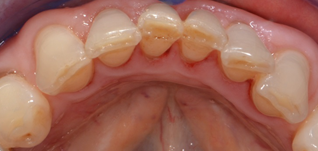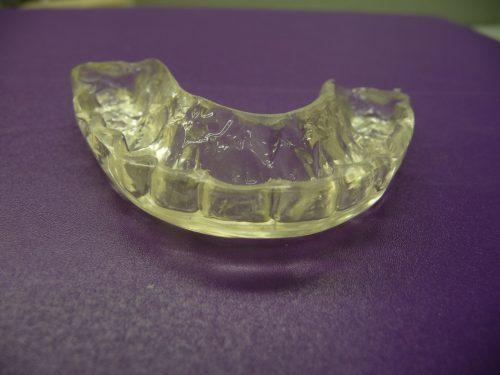Bruxism, commonly known as the clenching and/or tooth grinding of the teeth can affect all ages, from children to adults and is becoming more prominent. The clenching and grinding of teeth often occurs without the person even realising they are doing it, and can occur both during the day and most commonly at night. Clenching and tooth grinding can lead to enamel or tooth tissue loss, recession, can cause filling and tooth to flex and break, muscle tenderness- particularly in the cheek muscles, and temporomandibular joint (TMJ) discomfort.
There are several causes for tooth grinding: 
- stress and anxiety
- sleep disorders- grinding is common with people who suffer sleep aponea, where for a period of time the person stops breathing during sleep. In this case, grinding is used to try to open the airways to allow more oxygen saturation or intake during sleep. If you suspect you have sleep aponea, a sleep study is advised before any dental appliances are made.
- Poor occlusion or alignment of the teeth
- large tonsils and adnoids
- Teething- this is normally temporary.
Signs to be wary of if you suspect that you or someone you know is tooth grinding are:
- morning headaches, particularly around the temple
- tender or tight facial muscles, particularly around the cheeks
- shortened or jagged edges of teh teeth- noticed most on front and canine teeth
- making grinding sounds at night that may be heard by sleep partner or parents/siblings for children.
- Pain or discomfort when chewing
- scalloped or tooth indents on the tongue where the sides appear to have a wave-like pattern
- Cheek bite habit- appears as a white line along the inside of the cheek. Often people will use the cheek subconsciously between teeth to help with grinding.
So if you are a clencher or grinder, what can you do about it?
The difficulty with treating bruxism is that it often occurs without the person realising and/or during sleep. When tooth grinding begins to damage the teeth or creates discomfort, we recommend combining occlusal splint therapy with stress management to help manage and reduce the incidence of tooth grinding.
An Occlusal Splint can be likened to a mouth guard that is worn at night to protect the teeth. Unlike a sport mouth guard they are relatively slim in design. Splints are made with a rigid, thickened plastic used for biting surfaces of the teeth to withstand grinding pressure s. Rather than grinding away healthy tooth structure, your teeth will be cushioned against the plastic acrylic of the splint and pressure on the temporomandibular joint (TMJ) is relieved, easing jaw and muscle fatigue and headache symptoms. To get the most out of your occlusal splint, wear your splint every night and bring it along with you to your preventative care appointments to review for wear and replace as needed. If a splint is not used, overtime the wear can increase and more complex treatment may be needed as it can impact on your facial appearance and your bite.
s. Rather than grinding away healthy tooth structure, your teeth will be cushioned against the plastic acrylic of the splint and pressure on the temporomandibular joint (TMJ) is relieved, easing jaw and muscle fatigue and headache symptoms. To get the most out of your occlusal splint, wear your splint every night and bring it along with you to your preventative care appointments to review for wear and replace as needed. If a splint is not used, overtime the wear can increase and more complex treatment may be needed as it can impact on your facial appearance and your bite.
Stress reduction and conscious awareness throughout the day is also important in the management of tooth clenching and grinding, particularly during periods to stress or tasks requiring concentration. Limiting alcohol and caffeine consumpiton, particularly a few hours before bed can also reduce grinding incidence while sleeping.
Once you are aware that you are clenching and grinding, you may be surprised just how often you actually do it! If you suspect that you may be grinding your teeth or in need of a new occlusal splint, contact us to visit our team at Dentalspa Geelong for an evaluation on 03 5223 1555.
Return to blog

